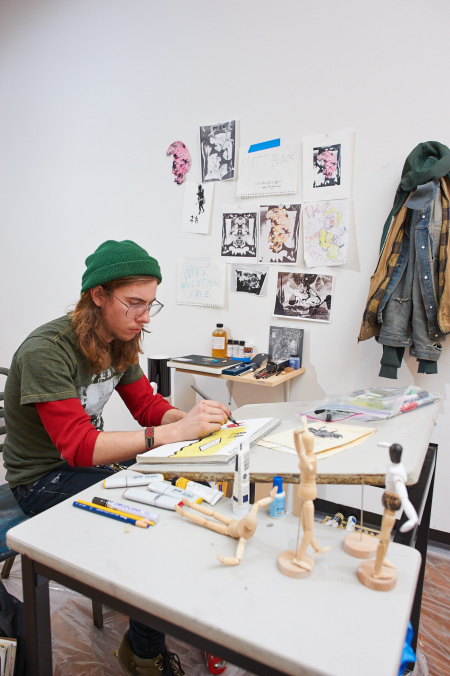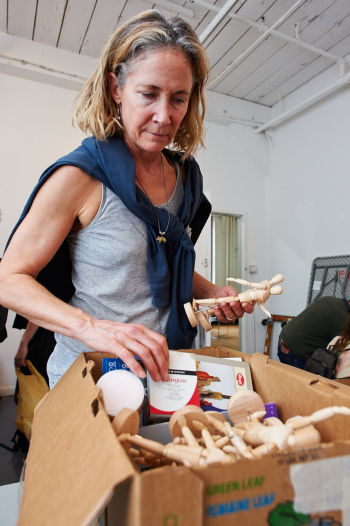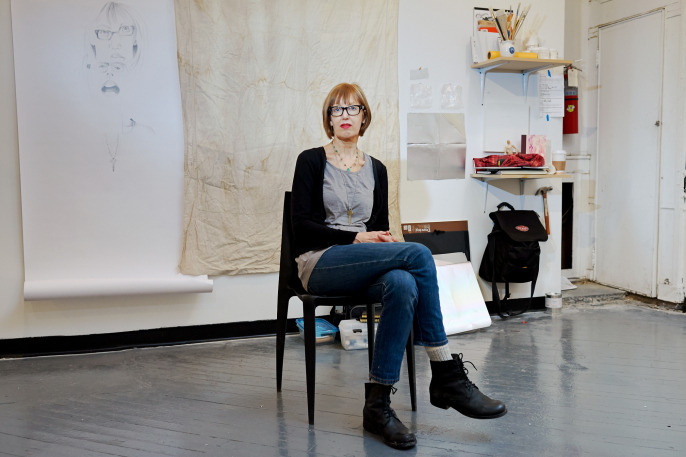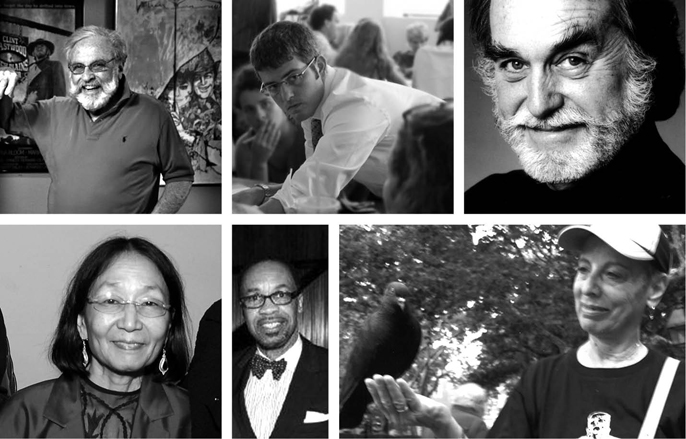RECOVERY FROM MAIN FIRE UNDERWAY AND RELOCATION COMPLETE
On Friday, February 15, a four-alarm fire broke out in Main Building. While there were no injuries, the fire destroyed the roof and the 6th floor of the building, caused significant smoke and water damage to the 5th floor, and all of the floors below suffered water damage as well. According to the New York City Fire Department, the cause of the fire remains under investigation despite press reports.
Students—as many as 200—lost artwork, including a large number of senior painting students who were preparing for their final thesis presentations.
“Senior year is about putting everything together you have learned, to try to get at who you are as an artist. That has been thrown off,” said Maria de los Angeles, a student who lost much of her work in the fire. “Our work represented everything we had learned. It is gone. It showed our chronological development. It feels like a piece of me was torn out. But I know it wasn't."
“Some students have lost all their work and are understandably experiencing major grief,” said Adjunct Professor Dennis Masback, who has been consoling students. “Some do not know the extent of their loss and are feeling frustrated and angry, while others incurred no loss at all, but nevertheless, are feeling sympathetic or even guilty, thinking, ‘Why them and not me?’”
In addition to the damage to the 6th floor studios and 5th floor classrooms, a number of departments within the School of Art and Design and some Institute-wide administrative offices, including those of the president and provost, were displaced. Damage incurred by the 1886 landmarked Romanesque Revival structure and its contents is currently being assessed by a disaster recovery firm contracted to work on remediation and salvage.
The Institute has been planning both short- and long-term recovery. By the Monday after the fire, all dislocated classes were held in new spaces, and by mid-week all offices and operations housed from the basement through the 4th floor of Main Building were relocated, for a total reallocation of 1,000 people and 40,000 square feet. Institute leadership has reached out extensively to support students as they regroup.
"I have been encouraged to see that many of our painting students were already back to work as early as last week in temporary studios throughout the campus. I remain confident that we will emerge from this stronger than ever as an institution," said President Thomas F. Schutte. "We continue to listen to concerns on the overall recovery process from all groups and to address those concerns in our planning."
A Fire Recovery Task Force, comprising senior leadership as well as affected students and faculty, has been created to coordinate and expedite programs and service to help students recover from fire-related losses and to address other issues affecting the community related to the impact of the fire. A Facebook page has been created for the Pratt campus to learn about fire-related news on topics ranging from art conservation to damaged works to campus space planning. A page on Pratt’s main website will feature the same fire-related content. The task force is ensuring that both students and faculty have opportunities to meet in small groups with President Schutte as well as key decision makers from the Facilities Department as recovery efforts move forward.
Outpouring of Support
In the days since the fire, offers of help from alumni and the greater community have been profound. Phones and emails have buzzed with offers of shared office space, furniture, equipment, and donations of art supplies from manufacturers and stores across the country. Museums including the Guggenheim and the New Museum invited students to visit with the admission waived. 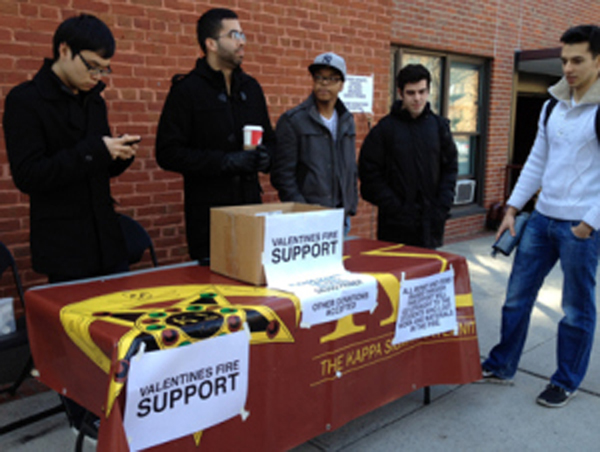 Students have been holding impromptu fundraisers, like this one outside the Student Union, to benefit displaced students.Students themselves have launched impromptu fundraising events including a pop-up art sale outside the Student Union, a sale sponsored by the Print Department, and student clubs have also made donations to recovery efforts.
Students have been holding impromptu fundraisers, like this one outside the Student Union, to benefit displaced students.Students themselves have launched impromptu fundraising events including a pop-up art sale outside the Student Union, a sale sponsored by the Print Department, and student clubs have also made donations to recovery efforts.
“The outpouring of concern and donations have been staggering, and it really reinforces the positive side of human nature,” said Painting Coordinator and Professor Shirley Kaneda. "The students who have been affected by this tragedy have also felt the generosity which only strengthens their commitment and experience at Pratt.”
The collective response to the fire from the community, both inside and outside of Pratt, demonstrates the connectedness of the greater Pratt community. As soon as the fire was reported, friends and alumni immediately began to commiserate on social media outlets, particularly Twitter and Facebook.
"The influx of support was instantaneous," said Kate Ünver, digital communications editor. "In my four years managing the Institute's Twitter account, I've never before witnessed such an overwhelming sense of community and concern, not only from students, faculty, staff, and Brooklyn residents, but from institutions across the region and nation." Pratt friends, including fellow art and design schools and libraries across the country, Tweeted their condolences and pledges of support.
Thank you again to all who have reached out to Pratt re: this morning's Main Building fire. How you can help: on.fb.me/VZflfZ
— Pratt Institute (@PrattInstitute) February 15, 2013
Moving Forward
Senior painters have relocated to the Steuben South Galleries, where they have already begun making art. They will remain at Steuben for the next couple of weeks while temporary studios are constructed in the south, far end of the gymnasium in the ARC Building for the rest of the semester.
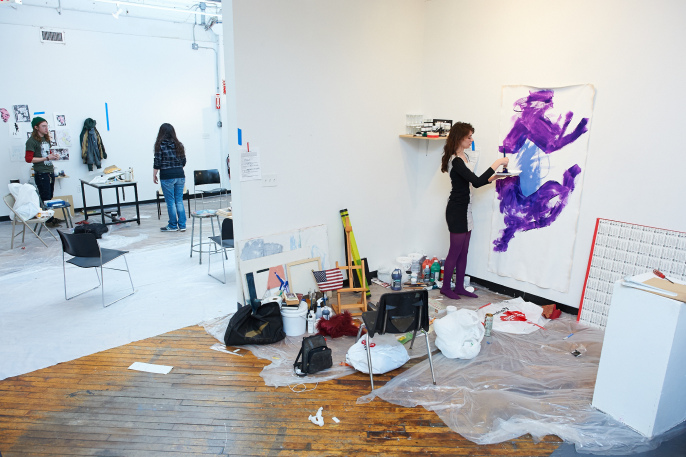 Painting students are using gallery space in Steuben Hall while temporary studios are constructed in the ARC Building.
Painting students are using gallery space in Steuben Hall while temporary studios are constructed in the ARC Building.
At a town hall meeting held by the task force, Institute leadership explained the design of the temporary structure, construction of which is slated to be complete March 18. Two separate zones will be created, replicating the functionality of the 5th and 6th floors. The first zone will have 44 individual painting studios, each almost 100 square feet—in some cases twice as large as the lost ones—and will also include a common pin-up area. A second zone will include two large painting studios and a smaller seminar room.
A number of students and faculty voiced their concern about ventilation, acoustics, and the lack of natural light. Glenn Gordon, executive director, Office of Planning, Design, Construction, and Facilities Management, explained that exhaust systems were being tested and would be upgraded if need be; adjacent noise would likely go up into the tall ceiling, not over into the studios; and, that the ARC ceiling would be painted white for better reflectivity. Other locations were considered, including off-campus venues, explained Provost Peter Barna, but the choice of the ARC Building was made largely because construction could begin immediately as the New York City Department of Buildings had expedited the approvals process for the campus site, making it the best choice, ensuring affected students could still get back to work and graduate on time. Barna emphasized that Institute leadership was eager to get feedback from both seniors and underclassmen on the ARC studios once they were in use.
One student brought up the risk of balls finding their way into the studio spaces. The administration explained that the basketball courts were on the other end of the gym and that if the tennis teams were using the space it would likely be early in the morning. One faculty member, who had been on the ground helping students regroup since the fire broke out, allayed the students fears. “We could crochet a really big net,” she interjected. “It could be a community effort.”
What You Can Do
Many alumni and friends have generously contacted the Institute to see how they might contribute to Pratt’s recovery efforts. The Main Building Recovery Fund has been established for those who would like to help students in need or with the reconstruction of Main Building.
If you are interested in making an in-kind donation, the Institute asks that you please reach out to the Fire Recovery Task Force at mainrecovery@pratt.edu.
Text: Bay Brown
Photos: Kevin Weeks

 Gateway Editors
Gateway Editors